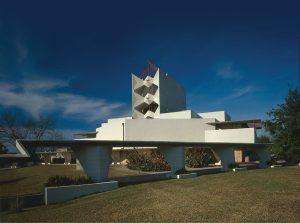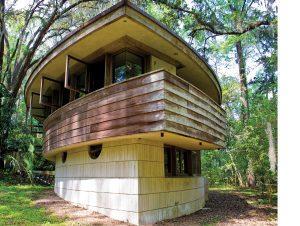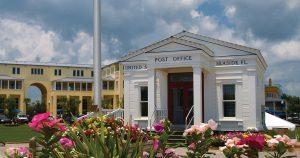Frank Lloyd Wright Architecture
Florida Southern College
Lakeland, FL
and Lewis Spring House
Tallahassee, FL
If you ask people on the street to name a famous architect, I can bet nine times out of ten, someone will mention Frank Lloyd Wright. He is an extremely well known American architect, writer, interior designer, and educator. He is considered to be one of the best architects of the 20th century, if not the best. Post-college, Wright became chief assistant to architect Louis Sullivan, also known as “the father of skyscrapers”, at an architectural firm called Adler and Sullivan; shortly thereafter, Sullivan and Wright parted ways and Wright started his own firm. He is most known for his organic style of architecture, known as “Prairie school”, for both homes and commercial buildings. Among the approximate 1,100 structures he designed in his lifetime, Florida is fortunate to be home to two Frank Lloyd Wright landmarks.
Aside from folks who are captivated by Frank Lloyd Wright architecture, Florida Southern College’s campus is relatively unfamiliar to most people, as it is tucked away in the small town of Lakeland, Florida, located centrally between Tampa and Orlando, Florida. That is, until the Princeton Review came out in 2011 and 2012, naming it the nation’s “most beautiful campus”. Since then, Florida Southern College has gained more attention from the general public. This allure even led to the renaming of a street the college is partially located on – converted from McDonald Street to Frank Lloyd Wright Way – and the construction of the Sharp Family Tourism and Education Center, located on 750 Frank Lloyd Wright Way. This welcome center, also known as a “Usonian” house, was designed in 1939 but not built until 2013. In total, the ten Frank Lloyd Wright buildings and two additional structures on this college campus amount to the largest concentration of Wright designed structures anywhere in the world. All are connected by the Esplanade, a 6 foot 8 inch covered walkway lined with a copper trim. You can take this low walkway to see the Annie Pfeiffer Chapel, whose tower is called “the bicycle rack in the sky”, or check out the Danforth Chapel, where many are mesmerized by the orange and gold stained glass windows, complete with Wright-designed pews. Thanks to Frank Lloyd Wright’s collaboration with Florida Southern College, Floridians and travelers alike can fully enjoy this fascinating architecture, which was also designated as a National Historic Landmark in 2012.
In Tallahassee, Florida, another Frank Lloyd Wright structure – although less prominent than Florida Southern College – is the Lewis Spring House. It is the only private residence designed by Frank Lloyd Wright in Florida. This unconventional, pod-shaped house, one of only two, is located on the outskirts of Tallahassee near Lake Jackson. The architectural plans for this house were formed by Wright in 1952, but the house did not come to fruition until December of 1954, when George and Clifton Lewis, along with their four children, happily moved into the home just before the New Year. The Lewis Spring House was placed on the National Register of Historic Places on February 14, 1979, and was chosen as one of “America’s 11 Most Endangered Historic Places®” in 2014 by The National Trust for Historic Preservation, which is the premiere preservation group in this country. Lewis Spring House is open to the public on the second Sunday of every month, as well as being available for scheduled personal tours any day that works for both parties. To learn more about Lewis Spring House, how you can donate to help restore this important piece of history, when to take a second Sunday tour or to schedule a personal tour, ways you can volunteer, and more, visit Spring House Institute’s website, PreserveSpringHouse.org.
New Urbanism Architecture
New Urbanism Towns
Seaside, FL and Celebration, FL
Another type of famous architecture found in Florida is the New Urbanism concept. This urban design movement encourages environmentally-friendly habits based on a design structure that is centered around walkability and a large array of housing and job options. To make headway on this form of architecture, the Congress for the New Urbanism (CNU) started in 1993, and its founders, Andrés Duany and Elizabeth Plater-Zyberk, two Miami-based architects, sought to change architecture in a transformative way. Backers behind the New Urbanism movement support the construction of vibrant communities where residents have ample choices when it comes to the ways in which they work, live and commute. A few of the design and development principles that accompany New Urbanism include connectivity, mixed use and diversity, smart transportation and walkability, sustainability, and quality of life. In short, well-designed communities equate to robust health, environment, and economy.
This was certainly the case when Duany and Plater-Zyberk began developing Seaside in 1980 and was founded in 1981. Located on the Florida panhandle in Walton County, Seaside is an 80-acre resort beach community whose architecture attracts visitors from all across the United States. It was created to emanate the size and character of historic Southern towns, securing a spot as a quintessential clean, white picket fence, beach community where everyone dreams of either living or visiting. This New Urbanism town is a “master-planned community”, meaning it was carefully thought out from its inception and was most likely built on a plot of land that was formerly an undeveloped area. Some of its famous architectural elements are towers, picket fences, and porches. But to fully appreciate this well thought out town, you’ll have to experience its beauty first-hand.
To better understand New Urbanism, I saw it said best on the website of Duany Plater –Zyberk & Co: “This well-known symbol of New Urbanism depicts the New Urbanism movement’s underlying principles, which can be applied to all urban conditions: the environment must be diverse in use and population; it must be scaled for the pedestrian yet capable of accommodating the automobile and mass transit; and it must have a well-defined public realm supported by an architecture that reflects the ecology and culture of the region.”
Another city based on New Urbanism principles is Celebration, Florida, located near Orlando, Florida and Disney World. In fact, it was the Walt Disney Company who unveiled its plans for the 5,000-acre town in 1996. It would feature: public spaces for community-goers to gather around; pedestrian-friendly, walkable streets to enhance connectivity; a multitude of quaint, shopping areas to enjoy; downscaled but diverse housing options; and quality schools, all within a compact downtown and style that emulated that of southern American village. While it has not flourished like that of Seaside, Florida, its use of the architectural concept of New Urbanism is still something to sit back and appreciate. ![]()
By Morgan Crawford and Byrd Lewis Mashburn









